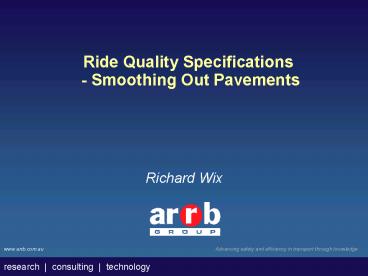www'arrb'com'auAdvancing safety and efficiency in transport through knowledge PowerPoint PPT Presentation
1 / 25
Title: www'arrb'com'auAdvancing safety and efficiency in transport through knowledge
1
Ride Quality Specifications - Smoothing Out
Pavements
- Richard Wix
2
Outcomes of Presentation
- What is ride quality and how does it relate to
road roughness? - How is ride quality measured?
- How can a basic understanding of IRI lead to a
road with a smoother ride?
3
Why is Ride Quality of Importance?
- Reduces dynamic loading
- Increases life expectancy
- Decreases road user costs
- Increases user satisfaction
- SRAs implementing Ride Quality testing for rehab
and new construction
4
What is Ride Quality?
- the level of ride comfort experienced by the
occupants of a vehicle as it traverses the
pavement - dependent on vertical acceleration experienced by
occupants - acceleration attributable to roughness
5
What is Roughness?
- a condition parameter which characterises
deviations from the intended longitudinal profile
of a road surface with characteristic dimensions
that affect vehicle dynamics... ride quality and
dynamic pavement loading (Austroads 2001) - a lack of smoothness
6
Roughness Measurement in Australia
- In 1970s ARRB in conjunction with SRAs developed
the NAASRA roughness meter - Response Type Road Roughness Measurement System
(RTRRMS) - Must be calibrated
7
Inertial Laser Profiler
- Introduced in Australia in the late 1980s to
calibrate NAASRA meter - Measurements are independent of vehicle dynamics
- Combines the outputs from a laser and
accelerometer to give profile
8
IRI - What is it?
- Outcome of the World Bank initiated IRRE in
Brazil in 1982 - Quarter car model (mathematical filter)
- High correlation to vertical passenger
acceleration at 80 km/h
9
Roughness is ?
Defects
.and everything in between
Dips
10
IRI Gain Response
2.4 m
15.4 m
11
Things to Keep in Mind When Smoothing out
Pavements
- Steps and construction joints
- Dips, humps and bumps
- Keeping it (the road surface) clean
- Site location and delineation
- Providing sufficient lead-in and lead-out
12
Steps
- a change in height that occurs at a discrete
point in the pavement (Austroads 2002) - short duration defect
- often occur at a bridge abutment or termination
of overlay
h
h step height
13
Effect of Step Height on IRI
14
Construction Joints
Usually manifested as a small dip or bump across
pavement
15
Avoiding Steps and Construction Joints
- Utilise a continuous paving technique to avoid
any discontinuity - When placing asphalt be wary of the supply truck
bumping the paver
16
Dips, Humps Bumps
- Long wavelength defect
- Built into underlying layers
- Minimal improvement in ride quality if thin
surfacing applied - Shape correction must be used to cater for longer
wavelength
17
Dips, Humps and Bumps
- 20 metre wave length
- 10 mm amplitude
- No surface defects
- IRI 2.34 m/km
18
Keeping the Road Surface Clean
- Surface contaminants can have a significant
effect on ride - Measuring device unable to differentiate dirt
from pavement - Sweep surface remove loose gravel, dirt and
clay - One of the easier things to do
19
Site Location Delineation
- Clearly identify start and end points using
physical markers - Meet the testing authority on site
- Utilise guides eg bollards to assist in tracking
if unsealed or no line marking
20
Lead-in
- Must be of sufficient length to reach operating
speed commence acquisition - Sufficiently long to avoid sharp acceleration
- Minimum 20 metres, ideal 50 metres
- Free of any defects (flow on effect)
21
Flow on Effect
22
If the surface is too rough.
- Correction will be required otherwise penalties
may apply - Identify offending section of pavement by
analysing data at a smaller interval - (Avoid need for rework by testing prior to
application of final surfacing)
23
Suitability of Measuring Equipment
- If IRI is required use a laser profiler or
Walking Profiler - Use an accredited supplier (this is stipulated by
several SRAs)
24
Conclusions
- Roughness (IRI) is a good measure of ride quality
- Roughness is more than just potholes and
corrugations - Penalties can be avoided if contractors are aware
of factors affecting ride quality - (Provision of incentives)
25
Thank you
- Questions???

